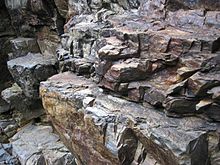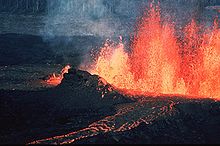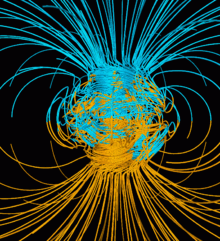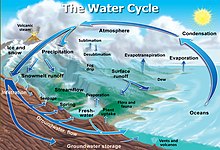Earth science

Earth scienceorgeoscienceincludes all fields ofnatural sciencerelated to the planet Earth.[1]This is a branch of science dealing with the physical, chemical, and biological complex constitutions and synergistic linkages of Earth's four spheres: thebiosphere,hydrosphere/cryosphere,atmosphere,andgeosphere(orlithosphere). Earth science can be considered to be a branch ofplanetary sciencebut with a much older history.
Geology[edit]

Geologyis broadly the study of Earth's structure, substance, and processes.Geologyis largely the study of thelithosphere,or Earth's surface, including thecrustandrocks.It includes the physical characteristics and processes that occur in the lithosphere as well as how they are affected bygeothermal energy.It incorporates aspects of chemistry, physics, and biology as elements of geology interact.Historical geologyis the application of geology to interpretEarth historyand how it has changed over time.
Geochemistrystudies the chemical components and processes of the Earth.Geophysicsstudies the physical properties of the Earth.Paleontologystudies fossilized biological material in the lithosphere.Planetary geologystudies geoscience as it pertains to extraterrestrial bodies.Geomorphologystudies the origin of landscapes.Structural geologystudies the deformation of rocks to produce mountains and lowlands. Resource geology studies how energy resources can be obtained from minerals.Environmental geologystudies how pollution and contaminants affect soil and rock.[2]Mineralogyis the study of minerals and includes the study of mineral formation,crystal structure,hazards associated with minerals, and the physical and chemical properties of minerals.[3]Petrologyis the study of rocks, including the formation and composition of rocks.Petrographyis a branch of petrology that studies the typology and classification of rocks.[4]
Earth's interior[edit]
This sectionmay contain materialnot related to the topic of the article.(August 2022) |

Plate tectonics,mountain ranges,volcanoes,andearthquakesaregeologicalphenomena that can be explained in terms of physical and chemical processes in the Earth's crust.[6]Beneath the Earth's crust lies themantlewhich is heated by theradioactive decayofheavy elements.The mantle is not quite solid and consists ofmagmawhich is in a state of semi-perpetualconvection.This convection process causes the lithospheric plates to move, albeit slowly. The resulting process is known as plate tectonics.[7][8][9][10]Areas of the crust where new crust is created are calleddivergent boundaries,those where it is brought back into the Earth areconvergent boundariesand those where plates slide past each other, but no new lithospheric material is created or destroyed, are referred to astransform(or conservative) boundaries.[8][10][11]Earthquakesresult from the movement of the lithospheric plates, and they often occur near convergent boundaries where parts of the crust are forced into the earth as part of subduction.[12]
Plate tectonics might be thought of as the process by which the Earth is resurfaced. As the result ofseafloor spreading,new crust and lithosphere is created by the flow of magma from themantleto the near surface, through fissures, where it cools and solidifies. Throughsubduction,oceanic crust and lithosphere vehemently returns to the convecting mantle.[8][10][13]Volcanoes result primarily from the melting of subducted crust material. Crust material that is forced into theasthenospheremelts, and some portion of the melted material becomes light enough to rise to the surface—giving birth to volcanoes.[8][12]
Atmospheric science[edit]
This sectionmay contain materialnot related to the topic of the article.(August 2022) |

(image not to scale.)
Atmospheric science initially developed in the late-19th century as a means to forecast the weather throughmeteorology,the study of weather.Atmospheric chemistrywas developed in the 20th century to measureair pollutionand expanded in the 1970s in response toacid rain.Climatologystudies theclimateandclimate change.[14]
Thetroposphere,stratosphere,mesosphere,thermosphere,andexosphereare the five layers which make up Earth's atmosphere. 75% of the mass in the atmosphere is located within the troposphere, the lowest layer. In all, the atmosphere is made up of about 78.0%nitrogen,20.9%oxygen,and 0.92%argon,and small amounts of other gases including CO2and water vapor.[15]Water vapor and CO2cause the Earth's atmosphere to catch and hold the Sun's energy through thegreenhouse effect.[16]This makes Earth's surface warm enough for liquid water and life. In addition to trapping heat, the atmosphere also protects living organisms by shielding the Earth's surface fromcosmic rays.[17]Themagnetic field—created by the internal motions of the core—produces themagnetospherewhich protects Earth's atmosphere from thesolar wind.[18]As the Earth is4.5 billionyears old,[19][20]it would have lost its atmosphere by now if there were no protective magnetosphere.
Earth's magnetic field[edit]

Earth's magnetic field,also known as the geomagnetic field, is themagnetic fieldthat extends fromEarth's interiorout into space, where it interacts with thesolar wind,a stream ofcharged particlesemanating from theSun.The magnetic field is generated byelectric currentsdue to the motion ofconvection currentsof a mixture of moltenironand nickel inEarth's outer core:these convection currents are caused by heat escaping from the core, a natural process called ageodynamo.
The magnitude of Earth's magnetic field at its surface ranges from 25 to 65 μT (0.25 to 0.65 G).[23]As an approximation, it is represented by a field of amagnetic dipolecurrently tilted at an angle of about 11° with respect toEarth's rotationalaxis, as if there were an enormousbar magnetplaced at that angle through the center of Earth. TheNorth geomagnetic poleactually represents the South pole of Earth's magnetic field, and conversely theSouth geomagnetic polecorresponds to the north pole of Earth's magnetic field (because opposite magnetic poles attract and the north end of a magnet, like a compass needle, points toward Earth's South magnetic field,Ellesmere Island,Nunavut,Canada).
While the North and Southmagnetic polesare usually located near the geographic poles, they slowly and continuously move over geological time scales, but sufficiently slowly for ordinarycompassesto remain useful for navigation. However, at irregular intervals averaging several hundred thousand years,Earth's field reversesand theNorthandSouth Magnetic Polesrespectively, abruptly switch places. These reversals of thegeomagnetic polesleave a record in rocks that are of value topaleomagnetistsin calculating geomagnetic fields in the past. Such information in turn is helpful in studying the motions of continents and ocean floors. Themagnetosphereextends above theionospherethat is defined by the extent of Earth's magnetic field in space orgeospace.It extends several tens of thousands of kilometres intospace,protecting Earth from the charged particles of thesolar windandcosmic raysthat would otherwise strip away the upper atmosphere, including theozone layerthat protects Earth fromharmful ultraviolet radiation.Hydrology[edit]

Hydrology is the study of the hydrosphere and themovement of water on Earth.It emphasizes the study of how humans use and interact with freshwater supplies. Study of water's movement is closely related togeomorphologyand other branches of Earth science. Applied hydrology involves engineering to maintain aquatic environments and distribute water supplies. Subdisciplines of hydrology includeoceanography,hydrogeology,ecohydrology,andglaciology.Oceanography is the study of oceans.[24]Hydrogeology is the study ofgroundwater.It includes the mapping of groundwater supplies and the analysis of groundwater contaminants. Applied hydrogeology seeks to prevent contamination of groundwater andmineral springsand make it available asdrinking water.The earliest exploitation of groundwater resources dates back to 3000 BC, and hydrogeology as a science was developed by hydrologists beginning in the 17th century.[25]Ecohydrology is the study of ecological systems in thehydrosphere.It can be divided into the physical study of aquatic ecosystems and the biological study of aquatic organisms. Ecohydrology includes the effects that organisms and aquatic ecosystems have on one another as well as how these ecoystems are affected by humans.[26]Glaciology is the study of the cryosphere, includingglaciersand coverage of the Earth by ice and snow. Concerns of glaciology include access to glacial freshwater, mitigation of glacial hazards, obtaining resources that exist beneath frozen land, and addressing the effects of climate change on the cryosphere.[27]
Ecology[edit]
Ecology is the study of thebiosphere.This includes the study of nature and of how living things interact with the Earth and one another and the consequences of that. It considers how living things use resources such asoxygen,water,andnutrientsfrom the Earth to sustain themselves. It also considers how humans and other living creatures cause changes to nature.[28]
Physical geography[edit]
Physical geography is the study ofEarth's systemsand how they interact with one another as part of a single self-contained system. It incorporates astronomy, mathematical geography, meteorology, climatology, geology, geomorphology, biology, biogeography, pedology, and soils geography. Physical geography is distinct fromhuman geography,which studies the human populations on Earth, though it does include human effects on the environment.[29]
Methodology[edit]
Methodologiesvary depending on the nature of the subjects being studied. Studies typically fall into one of three categories: observational, experimental, or theoretical. Earth scientists often conduct sophisticated computer analysis or visit an interesting location to study earth phenomena (e.g. Antarctica orhot spotisland chains).
A foundational idea in Earth science is the notion ofuniformitarianism,which states that "ancient geologic features are interpreted by understanding active processes that are readily observed." In other words, any geologic processes at work in the present have operated in the same ways throughout geologic time. This enables those who studyEarth historyto apply knowledge of how the Earth's processes operate in the present to gain insight into how the planet has evolved and changed throughout long history.
Earth's spheres[edit]
−13 — – −12 — – −11 — – −10 — – −9 — – −8 — – −7 — – −6 — – −5 — – −4 — – −3 — – −2 — – −1 — – 0 — |
| |||||||||||||||||||||||||||||||||||||||
In Earth science, it is common to conceptualize the Earth's surface as consisting of several distinct layers, often referred to as spheres: thelithosphere,thehydrosphere,theatmosphere,and thebiosphere,this concept of spheres is a useful tool for understanding the Earth's surface and its various processes[30]these correspond torocks,water,airandlife.Also included by some are thecryosphere(corresponding toice) as a distinct portion of the hydrosphere and thepedosphere(corresponding tosoil) as an active and intermixed sphere. The followingfields of scienceare generally categorized within the Earth sciences:
- Geologydescribes therockyparts of theEarth's crust(orlithosphere) and its historic development. Major subdisciplines aremineralogyandpetrology,geomorphology,paleontology,stratigraphy,structural geology,engineering geology,andsedimentology.[31][32]
- Physical geographyfocuses ongeographyas an Earth science. Physical geography is the study of Earth's seasons, climate, atmosphere, soil, streams, landforms, and oceans. Physical geography can be divided into several branches or related fields, as follows:geomorphology,biogeography,environmental geography,palaeogeography,climatology,meteorology,coastal geography,hydrology,ecology,glaciology.[citation needed]
- Geophysicsandgeodesyinvestigate theshape of the Earth,its reaction to forces and itsmagneticandgravity fields.Geophysicists explore theEarth's coreandmantleas well as thetectonicandseismicactivity of the lithosphere.[32][33][34]Geophysics is commonly used to supplement the work ofgeologistsin developing a comprehensive understanding of crustal geology, particularly in mineral and petroleum exploration.Seismologistsusegeophysicsto understand plate tectonic movement, as well as predict seismic activity.
- Geochemistryis defined as the study of the processes that control the abundance, composition, and distribution of chemical compounds and isotopes in geologic environments. Geochemists use the tools and principles of chemistry to study the composition, structure, processes, and other physical aspects of the Earth. Major subdisciplines areaqueous geochemistry,cosmochemistry,isotope geochemistryandbiogeochemistry.
- Soil sciencecovers the outermost layer of the Earth's crust that is subject tosoil formationprocesses (orpedosphere).[35]Major subdivisions in this field of study includeedaphologyandpedology.[36]
- Ecologycovers the interactions between organisms and their environment. This field of study differentiates the study of Earth from the study of other planets in theSolar System,Earth being its only planet teeming with life.
- Hydrology,oceanographyandlimnologyare studies which focus on the movement, distribution, and quality of the water and involves all the components of the hydrologic cycle on the Earth and its atmosphere (orhydrosphere). "Sub-disciplines of hydrology include hydrometeorology, surface water hydrology, hydrogeology, watershed science, forest hydrology, and water chemistry."[37]
- Glaciologycovers theicyparts of the Earth (orcryosphere).
- Atmospheric sciencescover thegaseousparts of the Earth (oratmosphere) between the surface and theexosphere(about 1000 km). Major subdisciplines include meteorology, climatology,atmospheric chemistry,andatmospheric physics.
Earth science breakup[edit]
- Hydrology
- Limnology(freshwater science)
- Oceanography(marine science)
- Chemical oceanography
- Physical oceanography
- Biological oceanography(marine biology)
- Geological oceanography(marine geology)
- Geology
- Geography
- Geochemistry
- Geomorphology
- Geophysics
- Geochronology
- Geodynamics(see alsoTectonics)
- Geomagnetism
- Gravimetry(also part ofGeodesy)
- Seismology
- Glaciology
- Hydrogeology
- Mineralogy
- Petrology
- Speleology
- Volcanology
- Systems
- Earth system science
- Environmental science
- Geography
- Gaia hypothesis
- Systems ecology
- Systems geology
- Others
See also[edit]
- American Geosciences Institute
- Earth sciences graphics software
- Four traditions of geography
- Glossary of geology terms
- List of Earth scientists
- List of geoscience organizations
- List of unsolved problems in geoscience
- Making North America
- National Association of Geoscience Teachers
- Solid-earth science
- Science tourism
- Structure of the Earth
References[edit]
- ^"Earth sciences | Definition, Topics, & Facts | Britannica".www.britannica.com.Retrieved2023-08-19.
- ^Smith & Pun 2006,pp. 14–16.
- ^Haldar 2020,p. 109.
- ^Haldar 2020,p. 145.
- ^Encyclopedia of Volcanoes.London: Academic Press. 2000.ISBN9780080547985.
- ^"Earth's Energy Budget".ou.edu.Archivedfrom the original on 2008-08-27.Retrieved2007-06-20.
- ^Simison 2007,paragraph 7
- ^abcdAdams & Lambert 2006,pp. 94–95, 100, 102
- ^Smith & Pun 2006,pp. 13–17, 218, G-6
- ^abcOldroyd 2006,pp. 101, 103, 104
- ^Smith & Pun 2006,p. 331
- ^abSmith & Pun 2006,pp. 325–26, 329
- ^Smith & Pun 2006,p. 327
- ^Wallace, John M.; Hobbs, Peter V. (2006).Atmospheric Science: An Introductory Survey(2nd ed.). Elsevier Science. pp. 1–3.ISBN9780080499536.
- ^Adams & Lambert 2006,pp. 107–08
- ^American Heritage,p. 770
- ^Parker, Eugene (March 2006),Shielding Space(PDF),Scientific American, archived fromthe original(PDF)on 2016-01-01,retrieved2017-05-24
- ^Adams & Lambert 2006,pp. 21–22
- ^Smith & Pun 2006,p. 183
- ^"How Did Scientists Calculate the Age of Earth?".education.nationalgeographic.org.Retrieved2023-08-19.
- ^Glatzmaier, Gary A.; Roberts, Paul H. (1995). "A three-dimensional self-consistent computer simulation of a geomagnetic field reversal".Nature.377(6546): 203–209.Bibcode:1995Natur.377..203G.doi:10.1038/377203a0.S2CID4265765.
- ^Glatzmaier, Gary."The Geodynamo".University of California Santa Cruz.Retrieved20 October2013.
- ^Finlay, C. C.; Maus, S.; Beggan, C. D.; Bondar, T. N.; Chambodut, A.; Chernova, T. A.; Chulliat, A.; Golovkov, V. P.; Hamilton, B.; Hamoudi, M.; Holme, R.; Hulot, G.; Kuang, W.; Langlais, B.; Lesur, V.; Lowes, F. J.; Lühr, H.; Macmillan, S.; Mandea, M.; McLean, S.; Manoj, C.; Menvielle, M.; Michaelis, I.; Olsen, N.; Rauberg, J.; Rother, M.; Sabaka, T. J.; Tangborn, A.; Tøffner-Clausen, L.; Thébault, E.; Thomson, A. W. P.; Wardinski, I.; Wei, Z.; Zvereva, T. I. (December 2010)."International Geomagnetic Reference Field: the eleventh generation".Geophysical Journal International.183(3): 1216–1230.Bibcode:2010GeoJI.183.1216F.doi:10.1111/j.1365-246X.2010.04804.x.hdl:20.500.11850/27303.
- ^Davie, Tim; Quinn, Nevil Wyndham (2019).Fundamentals of Hydrology(3rd ed.). Routledge. pp. 1–2.ISBN9780203798942.
- ^Hölting, Bernward; Coldewey, Wilhelm G. (2019). "Introduction".Hydrogeology(8th ed.). Springer. pp. 1–3.doi:10.1007/978-3-662-56375-5.ISBN9783662563755.Archivedfrom the original on 2022-08-16.Retrieved2022-08-16.
- ^Wood, Paul J.; Hannah, David M.; Sadler, Jonathan P. (2007). "Ecohydrology and Hydroecology: An Introduction".Hydroecology and Ecohydrology: Past, Present and Future.Wiley. pp. 1–6.ISBN9780470010174.
- ^Knight, Peter (1999).Glaciers.Taylor & Francis. p. 1.ISBN9780748740000.
- ^Ricklefs, Robert E.; Miller, Gary L. (2000).Ecology(4th ed.). W. H. Freeman. pp. 3–4.ISBN9780716728290.
- ^Petersen, James F.; Sack, Dorothy; Gabler, Robert E. (2014).Fundamentals of Physical Geography.Cengage Learning. pp. 2–3.ISBN9781285969718.
- ^Earth's SpheresArchivedAugust 31, 2007, at theWayback Machine.©1997–2000. Wheeling Jesuit University/NASA Classroom of the Future. Retrieved November 11, 2007.
- ^Adams & Lambert 2006,p. 20
- ^abSmith & Pun 2006,p. 5
- ^"WordNet Search – 3.1".princeton.edu.Archivedfrom the original on 2019-05-15.Retrieved2010-10-13.
- ^"NOAA National Ocean Service Education: Global Positioning Tutorial".noaa.gov.Archivedfrom the original on 2005-05-08.Retrieved2007-11-17.
- ^Elissa Levine, 2001, The Pedosphere As A Hubbroken link?
- ^Gardiner, Duane T."Lecture 1 Chapter 1 Why Study Soils?".ENV320: Soil Science Lecture Notes.Texas A&M University-Kingsville. Archived fromthe originalon 2018-02-09.Retrieved2019-01-07.
- ^Craig, Kendall."Hydrology of the Watershed".Archivedfrom the original on 2017-01-11.Retrieved2017-04-04.
Sources[edit]
- Adams, Simon; Lambert, David (2006).Earth Science: An illustrated guide to science.New York: Chelsea House.ISBN978-0-8160-6164-8.
- Haldar, S. K. (2020).Introduction to Mineralogy and Petrology(2nd ed.). Elsevier Science.ISBN9780323851367.
- American Heritage dictionary of the English language(4th ed.). Boston:Houghton MifflinCompany. 1992.ISBN978-0-395-82517-4.
- Simison, W. Brian (2007-02-05)."The mechanism behind plate tectonics".Archivedfrom the original on 2007-11-12.Retrieved2007-11-17.
- Smith, Gary A.; Pun, Aurora (2006).How Does the Earth Work? Physical Geologyand theProcess of Science.Upper Saddle River, NJ: Pearson Prentice Hall.ISBN978-0-13-034129-7.
- Oldroyd, David (2006).Earth Cycles: A historical perspective.Westport, CT: Greenwood Press.ISBN978-0-313-33229-6.
Further reading[edit]
- Allaby M., 2008. Dictionary of Earth Sciences, Oxford University Press,ISBN978-0-19-921194-4
- Korvin G., 1998. Fractal Models in the Earth Sciences, Elsvier,ISBN978-0-444-88907-2
- "Earth's Energy Budget".Oklahoma Climatological Survey. 1996–2004.Archivedfrom the original on 2007-11-17.Retrieved2007-11-17.
- Miller, George A.; Christiane Fellbaum; and Randee Tengi; and Pamela Wakefield; and Rajesh Poddar; and Helen Langone; Benjamin Haskell (2006)."WordNet Search 3.0".WordNet a lexical database for the English language.Princeton, NJ: Princeton University/Cognitive Science Laboratory.Archivedfrom the original on 2011-01-01.Retrieved2007-11-10.
- "NOAA National Ocean Service Education: Geodesy".National Oceanic and Atmospheric Administration. 2005-03-08.Archivedfrom the original on 2005-05-08.Retrieved2007-11-17.
- Reed, Christina (2008).Earth Science: Decade by Decade.New York: Facts on File.ISBN978-0-8160-5533-3.
- Tarbuck E. J., Lutgens F. K., and Tasa D., 2002. Earth Science, Prentice Hall,ISBN978-0-13-035390-0
